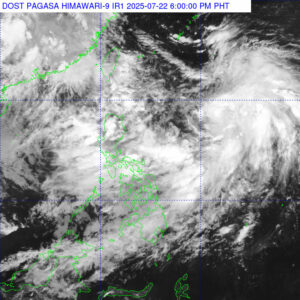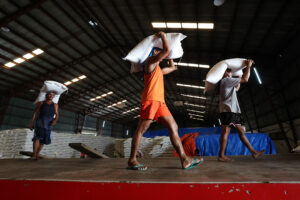By Kyle Aristophere T. Atienza and Kenneth Christiane L. Basilio, Reporters
THE LOW-PRESSURE area (LPA) east of Aurora province developed into a tropical depression on Tuesday, according to the state weather bureau, amid heavy rains caused by the southwest monsoon in northern and central Philippines.
Classes and government work in Metro Manila and some provinces in Luzon and the Visayas were suspended again for Wednesday amid flooding.
As of 3 p.m., Tropical Depression Dante was estimated at 1,120 kilometers east of Northern Luzon, with maximum sustained winds of 45 kilometers per hour (kph) near the center and gustiness of up to 55 kph, the Philippine Atmospheric, Geophysical and Astronomical Services Administration (PAGASA) said in a weather update.
It was moving north-northwestward at 20 kph. Meanwhile, a low-pressure area was spotted 155 kilometers east-southeast of Basco, Batanes.
Heavy rains caused the Marikina River’s water levels to reach the third and highest alarm, prompting the evacuation of more than 23,000 people in Metro Manila including Quezon City, the country’s largest city.
In Malabon, disaster officials pointed to a damaged floodgate in nearby Navotas as the cause of severe flooding.
As flooding persists, five dams in Luzon, including La Mesa Dam, have released water, with La Mesa’s water level breaching the 80.15-meter overflowing mark, PAGASA said on Tuesday morning.
Experts raised concerns over the Philippines’ disaster response, which they said remained reactive despite the country’s history of severe flooding.
“Clearly, what we’re seeing at the moment is that our flood preparedness and mitigation is not enough, despite the over P300 billion allocated for flood control this year,” Pamela Gloria Cajilig, a research fellow at the Resilience Development Initiative, said in an e-mailed reply to questions.
Amid public concerns over corruption, President Ferdinand R. Marcos Jr. vetoed P16.7 billion worth of flood control projects in the 2025 national budget.
Despite this, flood control still accounted for a third of this year’s infrastructure budget at P349.42 billion.
Party-list Rep. Terry L. Ridon, head of infrastructure think tank InfraWatch PH, urged the 20th Congress to review the delays in flood control projects.
“The delays should be subjected to a strict catch-up plan by concerned agencies in order to expedite completion within the most critical typhoon and monsoon months,” he said in a Facebook Messenger chat.
The Commission on Audit (CoA) flagged delays in the Metro Manila Flood Management Project, with 22 of the 58 projects already behind schedule by up to 310 days as of December 2023.
CoA also said 29 other flood control projects worth P371.03 million had yet to be implemented due to issues such as delayed procurement and cancellations.
Experts said certain development projects might be contributing to worsening flooding. The Metro Manila Development Authority (MMDA) earlier said the Manila Baywalk Dolomite Beach project, part of the Duterte administration’s initiative, blocked three major drainage outfalls, exacerbating floods in parts of Manila.
The Environment department, which oversees the project, has yet to respond to MMDA’s claim, but has attributed the flooding to the increasing volume of rainfall in the past decade.
‘SOCIAL AND POLITICAL CRISIS’Mr. Ridon, who has filed a resolution for a House of Representatives probe into the Dolomite Beach project, cited the need for a holistic approach to flood management. “If reclamation projects significantly contribute to flooding, the government should put a stop to further approvals of future reclamation projects,” he added.
Mahar Lagmay, executive director of the Nationwide Operational Assessment of Hazards (NOAH) project, noted that many of the flooded areas including Commonwealth Avenue in Quezon City used to be natural waterways converted into roads.
Ms. Cajilig sought a shift in the country’s approach to flood management, urging officials to stop viewing flooding solely as a technological issue.
“We urgently need to stop thinking about flooding in purely technological terms and reframe it as a social and political crisis,” she said. “We need to see flooding as a systemic crisis of inequity and injustice.”
She added that while improvements like enhanced hazard monitoring and early warning systems are in place, they remain “reactive and focused on response” rather than proactive preparedness.
The role of poor communities in disaster preparedness remains minimal, Ms. Cajilig said, citing the need for greater inclusion.
“We need the voices, knowledge, and capacities of those experiencing the greatest disaster risks,” she said. “We need to recognize that those experiencing the problems directly have crucial insight into ways forward.”
Maria Ela L. Atienza, a political scientist who has researched the impact of disasters on communities, also called for reviews of the Philippine Disaster Risk Reduction and Management Act of 2010.
She urged lawmakers to prioritize addressing the root causes of flooding, including inadequate governance and a lack of climate adaptation measures.
Gary Ador Dionisio, dean of the Benilde School of Diplomacy and Governance, said flood control should be part of a broader strategy to mitigate climate change.
“Flood control should be accompanied by bigger plans related to climate mitigation,” he said via Messenger chat, citing the need for long-term strategies such as modernizing the agriculture sector, which sustained P57.78 billion in damage from disasters last year.
Meanwhile, the Philippines activated military bases in the Philippines to serve as relief hubs to support humanitarian operations, Defense Secretary Gilberto C. Teodoro, Jr. said in a video posted on Facebook.
The US Indo-Pacific Command would also deploy a “crisis action team” and military assets to bolster relief efforts by the Philippine military, he added.
“Using these forward-operating hubs allows us to deliver aid faster and more efficiently to our fellow Filipinos, especially in hard-hit and remote areas,” Philippine military chief General Romeo S. Brawner, Jr. said in a separate statement.






